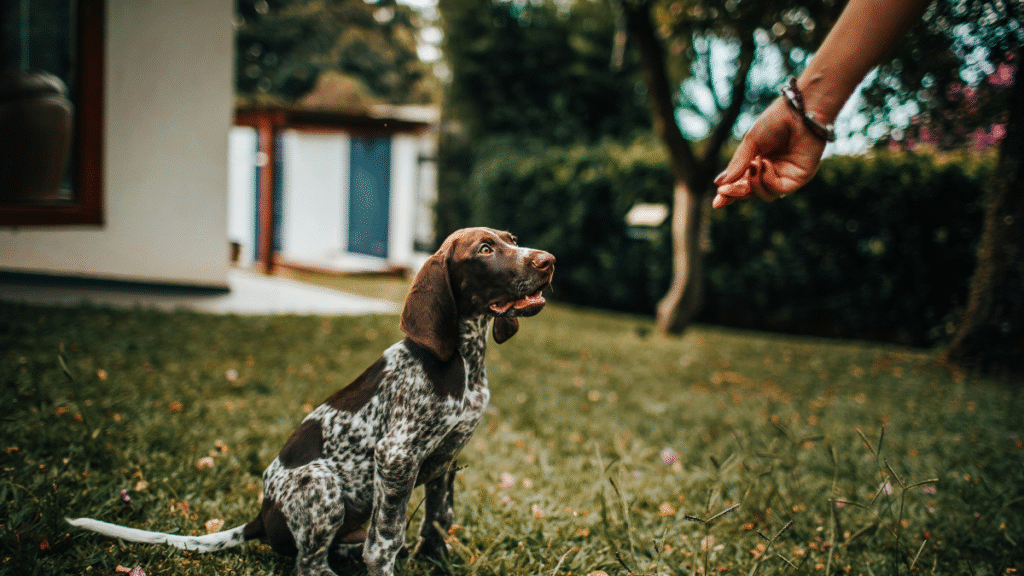Teaching your dog to shake hands is one of the cutest and most rewarding tricks you can show your pet. It’s not just an adorable behavior — it’s also a valuable skill that helps improve your dog’s obedience and responsiveness. “Shake” makes a great party trick and a fun icebreaker on walks or social outings.
Many dog owners believe it takes a long time to teach their pets to shake hands. While it’s true that some tricks can take days or even weeks to perfect, with the right technique, positive reinforcement, and a little patience, your dog can learn to “shake” or “give paw” in just one day.
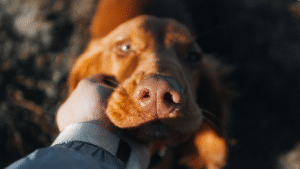
Why Should I Teach My Dog Tricks?
There are plenty of great reasons to teach your dog tricks — and “shake” is the perfect place to start. It’s simple, fun, and engaging for most dogs.
Beyond entertainment, trick training offers several important benefits:
-
Bonding: Training helps you and your dog communicate better and build mutual trust.
-
Obedience: Teaching simple tricks lays the groundwork for more complex commands later on.
-
Mental stimulation: Learning new tricks challenges your dog’s mind, keeps boredom away, and prevents destructive behaviors.
-
Confidence: Positive reinforcement helps shy or nervous dogs build confidence and enjoy interacting more.
Teaching tricks isn’t just fun — it’s an essential part of raising a well-behaved, well-rounded, and mentally healthy dog.
Dog Shaking Hands: Supplies You’ll Need
Before getting started, make sure you have the right supplies on hand. This will make the training process smoother and more effective.
-
Treats: Choose small, soft, and tasty treats your dog loves — such as chicken bits or special training treats.
-
Quiet space: Pick a calm area with minimal distractions so your dog can focus.
-
Clicker (optional): If you use clicker training, have your clicker ready. Otherwise, use a consistent marker word like “yes!” to signal good behavior.
-
Patience and positivity: Most importantly, bring a calm, encouraging attitude. Praise, gentle encouragement, and treats work far better than scolding or punishment.
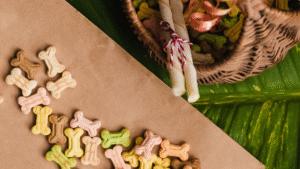
Teach Your Dog to Shake Hands in One Day: Step-by-Step Guide
Step 1: Get Your Dog’s Attention
Start by having your dog sit in front of you. (If your dog doesn’t know the “sit” command yet, practice that first.) It’s much easier to teach “shake” when your dog is sitting.
Hold a treat in your closed hand and let your dog sniff it. Don’t give it yet — just get your dog curious and focused on your hand.
Step 2: Encourage Paw Movement
Hold the treat in your closed fist slightly above your dog’s paw level and say your chosen cue — for example, “shake” or “paw.”
Most dogs will instinctively paw at your hand to get the treat.
The moment your dog lifts their paw, even slightly, mark the behavior with a click (if using a clicker) or say “yes!” Then immediately reward with the treat.
If your dog doesn’t lift their paw at first, gently tap or lift one paw yourself. As soon as their paw is in your hand, praise and reward them.
Repeat this process until your dog begins to associate touching your hand with earning a treat.
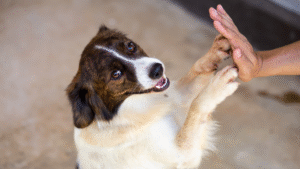
Step 3: Add the “Shake” Command
Once your dog reliably offers their paw, it’s time to introduce the verbal cue.
Say the word “shake” (or “paw”) just before your dog lifts their paw. Then, take their paw gently, give it a small shake, and reward.
Consistency is key — always give the command before the action so your dog connects the cue with the behavior.
After a few repetitions, your dog should begin lifting their paw as soon as you say “shake.”
Step 4: Practice and Reinforce
Keep training sessions short and positive — about 5–10 minutes at a time, two or three sessions throughout the day.
Always end on a positive note with praise and rewards.
By the end of the day, your dog will likely respond to “shake” consistently. Once your dog starts offering their paw without hesitation, begin rewarding intermittently — every other time — to reinforce the behavior without over-relying on treats.
Troubleshooting Common Problems
Even with simple tricks, some dogs need a bit more time. Here’s how to handle common training issues:
-
Dog won’t lift their paw:
Try using a more irresistible treat, such as small pieces of chicken or cheese. You can also gently lift their paw a couple of times while giving the command to show what you expect. -
Dog only offers one paw:
Just like humans, dogs often have a dominant paw. You can choose which paw to train first and teach the other later with a separate cue like “other paw.” -
Dog gets too excited:
If your dog starts jumping, barking, or scratching your hand, take a short break. Calmly ask for a “sit” before resuming training. -
Dog loses interest:
Training should be engaging but brief. If your dog gets bored or distracted, stop for now and try again later. Keeping sessions short and fun maintains motivation and focus.

Expanding the Trick: Add More Fun Skills
Once your dog masters “shake,” you can easily build on it to teach other impressive tricks:
-
High five: Hold your palm open and say “high five.” Reward when your dog touches your palm with their paw.
-
Wave: After learning “shake,” hold your hand slightly higher and reward when your dog lifts their paw without touching you.
-
Double shake: Teach your dog to offer both paws alternately for a fun variation.
These variations keep training exciting and challenge your dog’s coordination and concentration.
The Power of Positive Reinforcement
Positive reinforcement is the foundation of successful dog training. Rewarding desired behavior works far better than punishing mistakes.
Each time your dog performs the correct action, reward immediately — with a treat, enthusiastic praise, or gentle petting. This helps your dog associate the behavior with positive outcomes, making them eager to repeat it.
Avoid punishment or harsh corrections. Dogs learn best when they feel safe, supported, and confident.
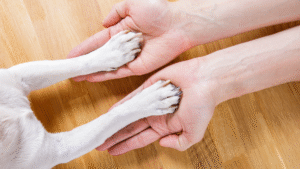
Essential Dog Training Tips
-
Use consistent cues: Stick with one command word (“shake”) and gesture throughout training.
-
Reward promptly: Timing matters — give the treat within a second or two of the correct behavior.
-
Keep sessions short: Two or three short sessions per day are more effective than one long one.
-
End on success: Always finish on a small win to keep your dog enthusiastic.
-
Be patient: Every dog learns at their own pace. Some grasp it in 10 minutes, others may need a few hours.
Training tricks like “shake” helps build communication, patience, and teamwork between you and your dog. When training feels fun and rewarding, your dog will be more eager to learn additional commands such as “sit,” “stay,” “roll over,” “fetch,” or “spin.”
Dogs thrive on praise, mental challenges, and interaction. The more you engage in positive, consistent training, the better your dog’s behavior will be overall. A dog that knows how to “shake” is often one that listens well, pays attention, and enjoys learning.
Conclusion
It’s absolutely possible to teach your dog to shake hands in just one day. This simple, charming trick is a great introduction to obedience and trick training.
Start with patience, treats, and a positive attitude. Keep sessions short, fun, and full of encouragement. By the end of the day, your dog will likely be offering their paw proudly whenever you ask — and you’ll have strengthened your bond through trust, communication, and shared success.
A well-trained, happy dog is one that feels connected to you — and “shake” is just the beginning of a lifelong partnership built on respect and joy.
- 5 Cheap Alternatives To Dog Training Equipment - November 12, 2025
- Homemade Calming Spray To Help Dogs During Training - November 12, 2025
- 7 DIY Dog Training Tools You Can Make From Household Items - November 12, 2025
